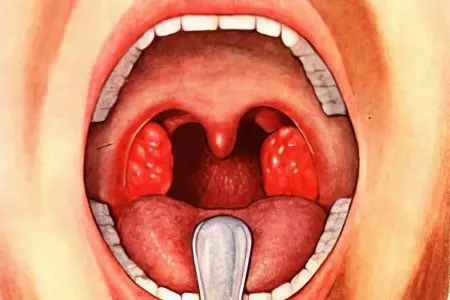Contents
Streptococcal pharyngitis is an inflammation of the mucous membrane of the throat, provoked by group A beta-hemolytic streptococcus.
According to statistics, the disease is most often diagnosed in children aged 5 to 15 years, but the development of inflammation in adults is not excluded. Boys and girls get sick with the same frequency.
Causes of streptococcal pharyngitis

The causes of streptococcal pharyngitis are reduced to damage to the mucous membrane of the throat with group A hemolytic streptococcus. Rarely, streptococci of groups C and G can also provoke acute pharyngitis.
The route of transmission of the disease is airborne, from one person to another. The more crowded the team, the higher the risk of infection. In this regard, streptococcal pharyngitis is more often diagnosed in the cold season among people who spend a long time in a closed team.
From time to time, group outbreaks of the disease are recorded due to the consumption of foods inseminated by streptococci.
During the acute phase of the disease, a large number of streptococci are determined in the mucous membrane of the throat. If therapy is not carried out, then they will parasitize in the upper respiratory tract for several more weeks and even months. In this case, the person will no longer experience symptoms of the disease. Even after a while, streptococci are not completely eliminated from the body, and the ill person becomes a carrier of the infection (provided there is no antibacterial treatment). Although the risk of transmitting the pathogen to other people outside the exacerbation phase is much lower.
Symptoms of streptococcal pharyngitis
Symptoms of streptococcal pharyngitis appear after the incubation period ends.
It is from 2 to 4 days. The following clinical picture is characteristic of the disease:
Acute onset of inflammation with severe sore throat. Pain tends to increase during swallowing.
A headache appears, a person experiences general malaise and weakness.
Body temperature rises, chills are possible. Often the mark on the thermometer exceeds the figure of 38,3 degrees.
In childhood, streptococcal pharyngitis often provokes vomiting, nausea, and abdominal pain.
The throat is red, swollen, the follicles on its back wall are enlarged.
The tonsils are hyperemic, edematous, on their surface a confluent or punctate exudate is found. The color of the mucus varies, it can be yellow, white or gray.
On the surface of the back wall of the throat, as well as on the tonsils, areas covered with exudate are visible. Their size can reach the head of a pin.
A sign indicating a streptococcal lesion of the throat may be a petechial enanthema on the soft palate.
Regional lymph nodes become enlarged and painful.
A scarlet-like rash may appear on the body.
The disease proceeds quite quickly and during the week its symptoms can stop on their own. The body temperature returns to normal on the third or fifth day, after which the symptoms from the respiratory organs disappear. The tonsils and lymph nodes take the longest to recover. They remain enlarged and painful for several more weeks.
Complications of streptococcal pharyngitis
A serious danger to human health is the complications of streptococcal pharyngitis.
Purulent complications include:
Otitis;
sinusitis;
Paratonsillar abscess;
Peripharyngeal abscess;
Purulent cervical lymphadenitis;
The formation of distant purulent foci – arthritis and osteomyelitis.
As for the formation of distant purulent foci, they are very rare in modern medical practice. Although before the discovery of penicillin, such complications developed in 13% of patients.
It is also important to recognize the formation of paratonsillar abscess in a timely manner, since this complication requires surgical intervention. The patient sharply increases pain in the throat, the body temperature rises, the neck area swells.
As for non-purulent complications of the disease, among them are:
The development of acute rheumatic fever, which manifests itself 14-21 days after the relief of the symptoms of the disease;
Glomerulonephritis of post-streptococcal etiology (develops most often on the 8-10th day from the onset of the disease);
Streptococcal toxic shock (develops at the same time as glomerulonephritis);
PANDAS syndrome (autoimmune neuropsychiatric syndrome).
Acute rheumatic fever develops most often if the patient has a hereditary predisposition to rheumatic heart disease, as well as when infected with rheumatogenic strains of streptococcus. Its beginning is indicated by a long recovery after an illness, palpitations, weakness, subfebrile body temperature.
Diagnosis of streptococcal pharyngitis

Diagnosis of streptococcal pharyngitis should be carried out in the laboratory.
After examining the throat by an otolaryngologist, it is possible to perform the following studies:
Microbiological examination of a smear taken from the posterior pharyngeal wall. Subject to all the rules for the collection and transportation of material, this method is 99% informative.
Express diagnosis of streptococcal antigen in a smear from the back of the throat. Express testing makes it possible to get results within 4-10 minutes. For analysis, there is no need for a special equipped laboratory. The sensitivity of the tests is up to 97%.
Immunoserological diagnostics.
Treatment of streptococcal pharyngitis
The drug of choice for the treatment of streptococcal pharyngitis is penicillin. For this, the patient is prescribed the intake of Phenoxymethylpenicillin inside for 10 days.
The goals of antibiotic therapy in this case are:
Destruction of the causative agent of inflammation;
Prevention of the development of complications, both purulent and non-purulent;
Reduced contagiousness;
The recovery of the patient.
An alternative drug is Amoxicillin, but when prescribing it, it is important to exclude infectious mononucleosis in order to ensure that the development of a toxic-allergic reaction is avoided.
If it is impossible to take penicillin, or there is no effect from its use, then the appointment of drugs from the group of cephalosporins (Cefixime, Ceftibuten, Cefuroxime Axetil) or macrolides (Erythromycin, Azithromycin, Clarithromycin, Josamycin, Spiramycin) is indicated.
It should be noted that early initiation of therapy reduces the severity of the course of the disease and significantly reduces the risk of complications. Treatment should continue for at least 10 days for complete eradication of the infectious agent. If the symptoms of the disease persist for 72 hours from the start of taking the antibiotic, then the drug must be changed.
Symptomatic therapy allows accelerating clinical recovery. To do this, rinse the throat with antiseptic and antibacterial solutions (Miramistin, Chlorophyllipt, Furacilin, Chlorhexidine, Biclotimol, etc.), irrigate the tonsils and the back wall of the throat with sprays (Ingalipt, Proposol, Hexoral, etc.).
NSAIDs are prescribed to relieve fever and reduce sore throat. If we are talking about children, then preference should be given to Paracetamol or Ibuprofen.
It is important to understand that local therapy is not able to replace systemic antibiotics for streptococcal pharyngitis.
A favorable prognosis for getting rid of pharyngitis of streptococcal etiology can only be given if the patient receives timely and adequate treatment.









